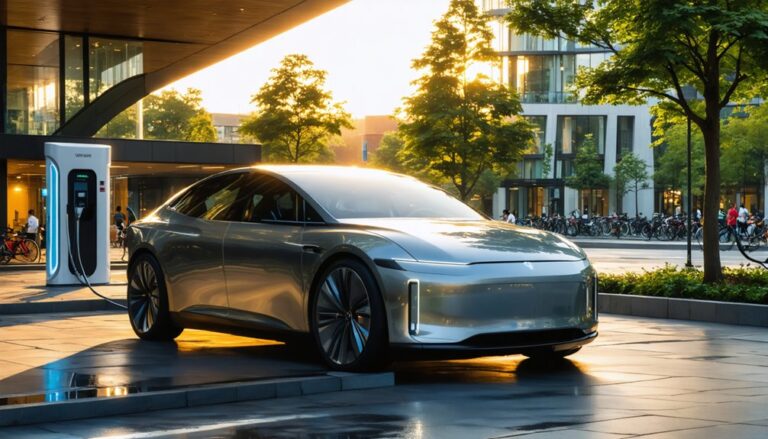Now is an excellent time to ponder purchasing a hybrid vehicle. The market is witnessing substantial growth, with strong consumer interest and improved affordability. Hybrids offer impressive fuel efficiency and performance advantages, complemented by various models available for diverse preferences. Additionally, the expansion of charging infrastructure and supportive government policies enhance their appeal. As the shift toward electrification accelerates, a hybrid could provide a pragmatic choice for environmentally conscious consumers. More perspectives on this topic are readily available, offering a deeper understanding, or a profound perspective.
Highlights
- With hybrid vehicles owning a 22% market share in the U.S., they demonstrate rising popularity among consumers.
- The average price of new hybrids has dropped to $33,255, making them more accessible to buyers.
- Significant operational savings, achieving 51-57 mpg, lead to reduced ownership costs over time.
- Federal tax credits of up to $7,500 and additional state incentives encourage buyers to choose hybrids.
- Improved charging infrastructure and maintenance services enhance the reliability and convenience of owning a hybrid vehicle.
Current Market Growth of Hybrid Vehicles
The current market growth of hybrid vehicles reflects a significant shift in consumer preferences and regulatory environments across the globe. Market analysis indicates that hybrid electric vehicles increasingly dominate U.S. light-duty sales, achieving 22% of the market share in Q1 2025, a rise from 18% the previous year. European markets show a similar pattern, with hybrid registrations growing by 14.1% year-over-year as petrol and diesel registrations decline sharply. Notably, hybrid-electric models now account for 34.7% of the total EU market share, further solidifying their position in the automotive landscape. Sales projections for the hybrid vehicle segment are strong, with an expected market value exceeding USD 857.05 billion by 2035, illustrating a compound annual growth rate of 10.2%. This evolution signals a promising future for hybrids, aligning with global efforts towards sustainable transportation. As efforts to promote renewable energy sources gain momentum, hybrid vehicles play a crucial role in reducing greenhouse gas emissions. Furthermore, many auto repair shops are gearing up to meet the demands of the growing EV and hybrid market.
Consumer Interest and Trends
Consumer interest in hybrid vehicles has risen substantially, reflecting a shift in priorities towards practicality and sustainability in transportation. Currently, 45% of Americans express openness to purchasing a hybrid for their next vehicle, surpassing the 33% who favor fully electric options. Demographic trends reveal a notable divide; younger adults and urban residents show heightened interest in electric vehicles, while concerns like range anxiety and charging logistics sway many towards hybrids. Additionally, the elimination of federal EV tax credits has redirected interest toward traditional hybrids, which offer greater convenience with up to 52 mpg fuel efficiency. These patterns highlight changing consumer preferences amidst growing environmental consciousness and practical considerations in vehicle choices across varied demographics. Interestingly, one-third of Americans say they would very or somewhat seriously consider purchasing an electric vehicle as their next vehicle. With hybrid sales increasing by 36%, the growing market share of hybrids signals a robust shift towards these vehicles as a viable option for consumers. Moreover, autonomous vehicles are gaining attention, illustrating the evolving landscape of consumer preferences in the automotive industry.
Economic Factors Influencing Hybrid Purchases
Amidst a shifting automotive scenery, economic factors substantially shape consumer decisions surrounding hybrid vehicle purchases. The average price of new hybrids is now more accessible, dropping to $33,255 in 2025, and used hybrid listings have surged by 11%. This competitive pricing, alongside substantial operational savings—such as achieving 51-57 mpg—contributes to reduced ownership costs. Additionally, the market’s expansion stems from improved manufacturing efficiencies, making maintenance expenses more manageable. Moreover, consumers are increasingly attracted to hybrid cars due to their enhanced fuel efficiency, reducing reliance on gasoline and further supporting economic savings. As consumers increasingly prioritize fuel efficiency and regulatory pressures mount, hybrids are gaining traction, representing 22% of new light-duty vehicle sales. This shift reflects a growing desire for environmentally friendly yet practical options, aligning with broader trends toward reduced emissions while maintaining affordability in ownership. Furthermore, many hybrid vehicles use less fuel than comparable models, appealing to budget-conscious shoppers.
Comparing Hybrid and Electric Vehicles
A growing conversation surrounds the comparison between hybrid and electric vehicles as consumers delve into increasingly diverse automotive options. Electric vehicles (EVs) operate solely on an electric motor, boasting zero tailpipe emissions and often lower overall emissions compared to traditional gasoline cars. In contrast, hybrids use both gasoline and electric power, which can produce emissions when the gasoline engine operates. Battery life varies, with EVs now achieving ranges exceeding 250 miles per charge. Additionally, most EVs can be charged using a standard 120 V outlet, which adds convenience for consumers looking to adopt electric vehicle charging at home. Hybrids provide flexibility with familiar refueling methods and high fuel efficiency, making them attractive for long-distance travel. For instance, the 2025 Kia Niro Hybrid offers an impressive 42 combined EPA MPG, showcasing the fuel efficiency advantages of hybrid vehicles. Ultimately, the choice between these technologies hinges on individual driving patterns, needs for infrastructure, and the desire for sustainability, reflecting a personal commitment to their environment, as consumers investigate increasingly diverse automotive options. Hybrid vehicles offer a great balance of performance and fuel economy for those prioritizing efficiency.
Fuel Efficiency and Performance Advantages
Fuel efficiency and performance advantages have become significant factors in the discussion of hybrid vehicles. The 2025 Toyota Prius leads with an impressive 57 MPG combined, highlighting the exceptional fuel savings that hybrids can provide. Other models, such as the Hyundai Elantra Hybrid and Toyota Camry Hybrid, showcase commendable performance with ratings of 54 MPG and 51 MPG combined, respectively. Particularly, hybrids excel in city driving with their sturdy low-end torque, providing satisfying engine performance without compromising efficiency. Features like Regenerative braking and automatic engine shutoff further enhance fuel-saving capabilities. With a growing market emphasizing these advantages, the 2025 Toyota Corolla ranks #1 in Best Hybrid Sedans Under $45,000, making it a popular choice among consumers. Many drivers find that choosing a hybrid truly supports their desire for both sustainability and spirited driving experiences.
Increasing Availability and Model Variety
The increasing availability and variety of hybrid vehicles mark a revolutionary phase in the automotive market. Consumers can now choose from a diverse range of hybrid models across various categories, including SUVs, sedans, and even pickup trucks. With brand expansion evident in the 2025 model year, notable entries like the Honda CR-V Hybrid and Ford Maverick Hybrid cater to different preferences and needs. Luxury brands also accept hybrid technology, integrating it into their products, such as the Mercedes-Benz S 580e and Lexus UX Hybrid. Furthermore, Toyota expects half its new car sales to be electrified in 2025, showcasing the commitment of major manufacturers to hybrid technology. The 2025 Toyota Corolla Hybrid is the most affordable option with a starting price of $24,920 and is yet another example of the expanding hybrid options available. This model diversity, alongside innovative hybrid technologies, enhances consumer choice in a competitive market, ensuring there’s a suitable option for everyone. As the scenery evolves, belonging to the hybrid movement becomes increasingly accessible for all drivers, ready to plunge into the trend, and the automotive industry is poised for a significant leap, transforming the entire terrain.
Infrastructure and Service Readiness for Hybrids
As the hybrid vehicle market continues to expand, the supporting infrastructure and service network have simultaneously evolved to meet the growing demand. Major automakers operate over 15,000 certified service centers nationwide, ensuring service conveniences are readily available to hybrid owners. The temporarily unavailable stations ensure that maintenance is prioritized, allowing for uninterrupted service when the vehicles are back online. Additionally, with the US fast charging network expected to surpass 100,000 ports by 2027, hybrid owners will benefit from improved access to charging infrastructure. The training of over 35,000 certified technicians since 2015 enhances maintenance capabilities, leading to quicker service appointments and improved reliability—92% of hybrid owners report no significant powertrain issues in the first five years. Furthermore, 95% of U.S. emergency response agencies have received training on hybrid safety protocols. With strong parts supply and established roadside assistance processes, the hybrid ecosystem is well-prepared, allowing owners to experience worry-free driving while nurturing a sense of community and security among hybrid vehicle enthusiasts. Moreover, a notable improvement in charging reliability is being observed, making the infrastructure even more dependable for hybrid users.
Government Policies and Regulatory Support
An increasingly supportive regulatory environment has emerged alongside the developing hybrid vehicle infrastructure, reinforcing the market’s expansion. Federal tax credits—up to $7,500—are available for qualifying new plug-in hybrid electric vehicles, stemming from the Inflation Reduction Act of 2022. Particularly, there are no sales caps restricting these credits once tied to vehicle counts. Additionally, state and local governments offer various incentives, such as grants and carpool lane access, further encouraging hybrid adoption. However, eligibility requirements demand that buyers remain aware of income and vehicle price limits. Vehicles with final assembly in North America must meet this criterion to qualify for these tax credits. These tax credits and government incentives play a crucial role in shaping consumer choices, stimulating interest, and promoting a collective movement towards more sustainable transportation options.
Future Outlook for Hybrid Vehicles
Future projections for hybrid vehicles indicate a sturdy market path, with significant growth anticipated in the coming decade.
The global hybrid vehicle market, valued at USD 314.24 billion in 2024, is projected to reach USD 4,004.51 billion by 2035, reflecting an impressive compound annual growth rate (CAGR) of 26.03% from 2025 to 2035.
As technological advancements enhance performance and efficiency, consumer interest is expected to rise, addressing range anxiety while offering substantial environmental benefits.
The automotive industry increasingly views hybrids as vital in overcoming the plateau in electric vehicle (EV) sales.
With manufacturers committing to hybrid technology, consumers can enjoy a practical shift toward full electrification, nurturing a sense of community and shared responsibility for the environment.
References
- https://www.greencars.com/news/hybrid-vehicles-claim-bigger-market-share-in-2025
- https://www.eia.gov/todayinenergy/detail.php?id=65384
- https://www.pewresearch.org/science/2025/06/05/americans-interest-in-purchasing-electric-and-hybrid-vehicles/
- https://www.automotiveresearch.com/insights/2025-update-battery-electric-and-hybrid-vehicle-trends
- https://www.marketresearchfuture.com/reports/hybrid-vehicle-market-6025
- https://www.bts.gov/content/gasoline-hybrid-and-electric-vehicle-sales
- https://www.acea.auto/pc-registrations/new-car-registrations-0-1-in-august-2025-year-to-date-battery-electric-15-8-market-share/
- https://caredge.com/guides/electric-vehicle-market-share-and-sales
- https://www.researchnester.com/reports/hybrid-vehicle-market/4772
- https://www.virta.global/global-electric-vehicle-market



